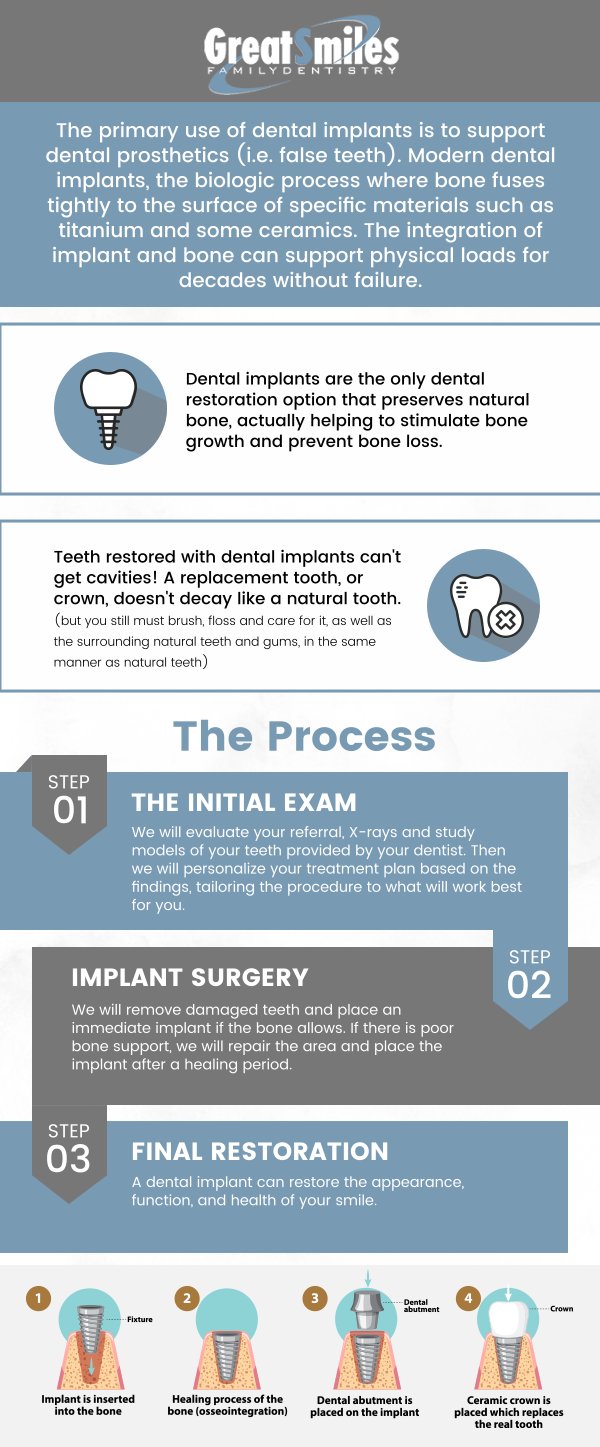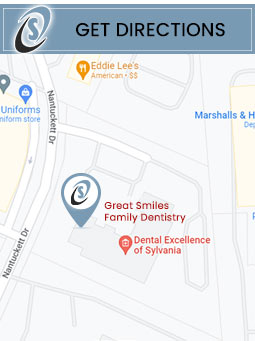Dental Implants: What You Should Know?
At Great Smiles Family Dentistry, Dr. Nadeem Khan provides expert dental implant services to restore missing teeth with natural-looking, durable solutions. Dental implants offer long-lasting results, improving both function and aesthetics for a confident smile. Schedule a consultation to learn how dental implants can enhance your oral health and overall well-being. Contact us today for more information. We are conveniently located at 4646 Nantuckett Dr Suite D, Toledo, OH 43623.


Table of Contents:
How much time do you go without teeth during the implant process?
How many teeth do you need for implants?
Will I need a dental implant right after a tooth extraction?
Can a dental implant procedure be completed in just one visit?
Dental Implants: What You Should Know — Dr. Nadeem Khan Explains in Toledo, OH
Dental implant treatment is a two-step process that generally extends over several months. The first phase is the implantation, where we surgically place small titanium posts, or implants, into your jawbone. These serve as the foundation for your future dental prosthesis. The healing period after this procedure can take a few weeks to months, allowing for the implants to become fully integrated with your bone.
The second phase, known as prosthetic reconstruction, begins once the implants are securely fused with the jawbone. Impressions will be taken to create custom crowns, bridges, or dentures, which are then attached to the dental implants. Once the prosthetics are made, they are fitted and secured onto the implants. How long you go without teeth is influenced by your current oral condition, how many teeth need to be replaced, and the specific implant treatment you’re undergoing.
In some instances, we can provide immediate load dental implants or same-day implants, which means you won’t go without teeth at any point during the process. However, these may not be suitable for everyone, particularly for more complex cases, like when you need to have teeth extracted or if you have a significant amount of bone loss. If you require a longer waiting period, you may need to wear temporary dentures while the extraction site heals or for bone grafts to take hold before the implants can be inserted. This healing process can range from 3 to 9 months.
The number of teeth replaced with dental implants varies based on individual needs. If you’ve lost one tooth, the best approach to fill the gap is with a single-tooth implant. However, if several adjacent teeth are missing, an implant-supported bridge may be used, which involves placing implants at both ends of the gap and connecting them with a bridge.
For those missing all their teeth in either the upper or lower jaw, implant-supported dentures may be the best solution. The exact number of implants required for implant-supported dentures depends on the quality of the bone, the location of the missing teeth, and individual needs. Your dentist will evaluate your jaw bone density and general oral wellness to establish the best implant solution for you.
No, you don’t have to get a dental implant immediately after extraction. The decision to place an implant right away depends on several factors, including your overall oral health and jawbone condition.
In certain circumstances, immediate placement of a dental implant, where the implant is inserted into the fresh extraction site, can help preserve the jawbone structure and avoid the bone loss that often follows tooth extraction. This method also shortens the overall treatment time since there’s no need to wait for the site to heal before placing the implant.
That said, not all patients are candidates for immediate implants. If the extraction site is infected or if you have insufficient bone density, delaying the implant might be a safer choice. To ensure the jaw is strong enough for an implant, some patients may need a bone graft first.
For others, waiting a few months after extraction allows the site to heal fully, reducing the risk of complications like infection or implant failure. Your dentist’s guidance is essential in figuring out the right timing for your circumstances and ensuring the best possible results.
Yes, dental implants can sometimes be done in one day, but it depends on various factors specific to each patient. Known as same-day implants or Teeth in a Day, this process allows for the placement of both the implant and a temporary crown during a single session. This approach offers an immediate improvement in the appearance and functionality of your teeth, which can be particularly appealing to those wanting a quick solution for missing or damaged teeth.
It’s crucial to note that this approach is not recommended in all cases. Ideal candidates need to have sufficient bone density and good oral health to support immediate implant placement. Additionally, certain health conditions like uncontrolled diabetes or smoking habits may increase the risk of complications, making same-day implants less suitable for some individuals. A thorough consultation session with your dentist will determine if this technique is right for you.
While the implant can be placed in a single visit, the overall healing process still takes time. During the months following implant placement, patients must follow strict aftercare instructions, including maintaining oral hygiene and following a soft-food diet to ensure the success of the implant. If you’re considering same-day implants, schedule a consultation with your dentist to discuss whether this treatment is suitable for your needs and health conditions.
Before proceeding with implants, it’s essential to understand all aspects of the treatment and associated costs. Your dentist may offer alternative financing options, such as payment plans or dental savings programs, to help manage the cost. Exploring these options can make implants more accessible and reduce financial stress.
Before getting dental implants, Dr. Nadeem Khan ensures that every patient fully understands the process, benefits, and care involved. At Great Smiles Family Dentistry, consultations include detailed assessments using 3D imaging and bone evaluations to determine candidacy. Patients receive personalized explanations about treatment phases, healing expectations, and long-term maintenance.
Practicing dentistry since 1995, Dr. Khan combines his expertise in cosmetic and family dentistry to deliver predictable, natural-looking implant results. Toledo residents appreciate his transparent communication and calm, educational approach, which reduces anxiety and builds confidence in their treatment choice. With Dr. Khan’s guidance, patients achieve smiles that not only restore aesthetics but also enhance overall oral health and quality of life. Contact us today for more information. We are conveniently located at 4646 Nantuckett Dr Suite D, Toledo, OH 43623. We serve patients from Toledo OH, Ottawa Hills OH, Sylvania OH, Holland OH, Rossford OH, Oregon OH, Maumee OH, Perrysburg OH, and surrounding areas.

Check Out Our 5 Star Reviews


Additional Services You May Need
- Affordable Dental Implants
- Invisalign
- Invisalign vs Braces
- Dental Implants
- Dentures
- Dentist
- Gum Disease
- Sleep Apnea Appliance
- Sedation Dentistry
- General & Cosmetic Dentistry
- Jaw Muscle and Joint Conditions
- Sports Guards
- Teeth Grinding
- Porcelain Veneers
- Lumineers
- Family Dentist
- Cosmetic Dentistry
- Dental Implant Costs
- Kid Friendly Dentist
- Gingivitis Treatments
- Pediatric Dentist
- Teeth Whitening
- Invisalign Clear Aligner
- Emface
- Exion
- Dental Crown
- Dental Bridge

Additional Services You May Need
- Affordable Dental Implants
- Invisalign
- Invisalign vs Braces
- Dental Implants
- Dentures
- Dentist
- Gum Disease
- Sleep Apnea Appliance
- Sedation Dentistry
- General & Cosmetic Dentistry
- Jaw Muscle and Joint Conditions
- Sports Guards
- Teeth Grinding
- Lumineers
- Porcelain Veneers
- Family Dentist
- Cosmetic Dentistry
- Dental Implant Costs
- Kid Friendly Dentist
- Gingivitis Treatments
- Pediatric Dentist
- Teeth Whitening
- Invisalign Clear Aligner
- Emface
- Exion
- Dental Crown
- Dental Bridge





